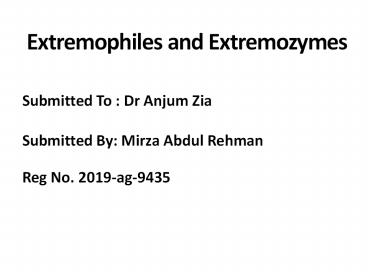Enzyme - PowerPoint PPT Presentation
Title:
Enzyme
Description:
Enzyme Types – PowerPoint PPT presentation
Number of Views:5
Title: Enzyme
1
Extremophiles and Extremozymes
Submitted To Dr Anjum Zia
Submitted By Mirza Abdul Rehman
Reg No. 2019-ag-9435
2
Extremophiles
- Extremophiles are organisms that lives optimally
under one or both environmental extremes. - Polyextremophiles grow optimally under multiples
extremes. - they dont just survive, they thrive. In other
words, extremophiles is microorganism mostly
archaeon that live in extreme conditions.
Extremozymes
Enzymes produced by extremophiles which
consequently function best under the
corresponding extreme conditions.
3
Thermophiles
Audophiles
Psychrophiles
Extremophiles
Alkaliphiles
Osmophiles
Barophiles
Xerophiles
Halophiles
4
Extreme Conditions
- Temperature
- Ph
- Salinity
- Nutritional scarcitives
- Absence of oxygen
- Radiation
- Pressure
5
Types
6
Psychrophiles
- Temperature range is -15 to 15C.
- Also known as cryophiles.
- Isolated from arctic and antarctic habitats.
- Also found in ice bergs, galciars, snow falls
etc. - Metabolism is quite normal at colder
temperatures. - Proteinacious antifreeze mechanism to protect the
cell and DNA. - Some of them cause spoilage in refrigerated food
materials. - E.g (1) Pseudomonas (2) Sphingomonas (3)
Arthrobacter
7
Thermophiles
- Greek Word thermotita (heat) and philia (love)
- Temperature loving organism
- Most members are archae
- Grows in temperature range of 55 to 113C
- Mostly found in geothermally heated region on
earth viz hot springs, hydrothermal vents etc. - As they need extreme temperature, its very hard
to study them in laboratory condition. - Also that some members can produce heat by
themselves. - Examples are (1) Cyonidium Caldarium (2)
Chaetomium Thermophile - Thermophiles are further classified into obligate
and Facultative thermophiles.
8
Acidophiles
- Micro organisms that lives in highly acidic
environments are called as acideophiles. - The PH range is 1-5
- Some members that mainly found in drainage of
coal miner are able to oxidize sulphur into
sulphuric acid. - Mechanism of action is thatthey have a proton
pump machinery to eliminate protonfrom
cytoplasmof the cell to maintain low ph. - E.g (1) Pyrodictium (2) Picrophilus
(3) Ferroplasma (4) Sulfolobus
9
Alkaliphiles
- These are extremophilic microorganisms which
thrives in roughly alkaline environment (8-11)
and have an optimum PH around 10. - Organisms which needs high Ph to survive are
called obligate alkaliphiles. - There are facultative alkaliphiles and
haloalkaliphiles (need salty environment as well) - Most of the alkaliphiles posses bacillus
morphology. - E.g (1) Bacillus halodurans (2) Bacillus
firmus
10
Xerophiles
- A xerophile is an extremophilic organism that can
grow and reproduce in conditions with a low
availablity of water. - Water activity is a measure of the amount of
water within a substrate an organism can use to
support sexual growth - Xerophiles often said to be xerotolerant
meaning tolerant to dry condition they can
survive in environment with water activity below
0.8 - Endoliths and halophiles are often xerotolerant.
- E. g (1) many molds and Yeast (2)
Trichosporonoids nigrescens
11
Halophiles
- This group comprises microorganisms that can
thrive in high salty environment such as the
great salt lake and dead sea. - Most of the Halophiles belongs to Domain Archai
- E.g Salinibactem ruber
- There are eukaryotic halophiles such as
Dunalicela Salina (algae) and wallemia
icthyophaga (fungus) - Obligate halophiles adopted to survive in high
salt concentrations. - Organisms from the Dead Sea often requires nearly
33 salt. (sea water has only 3) and inoculating
loop must be dipped in a saturated salt solution
to isolate them. - Microorganisms live in such high salinity are
termed as extreme halophiles.
12
(No Transcript)































